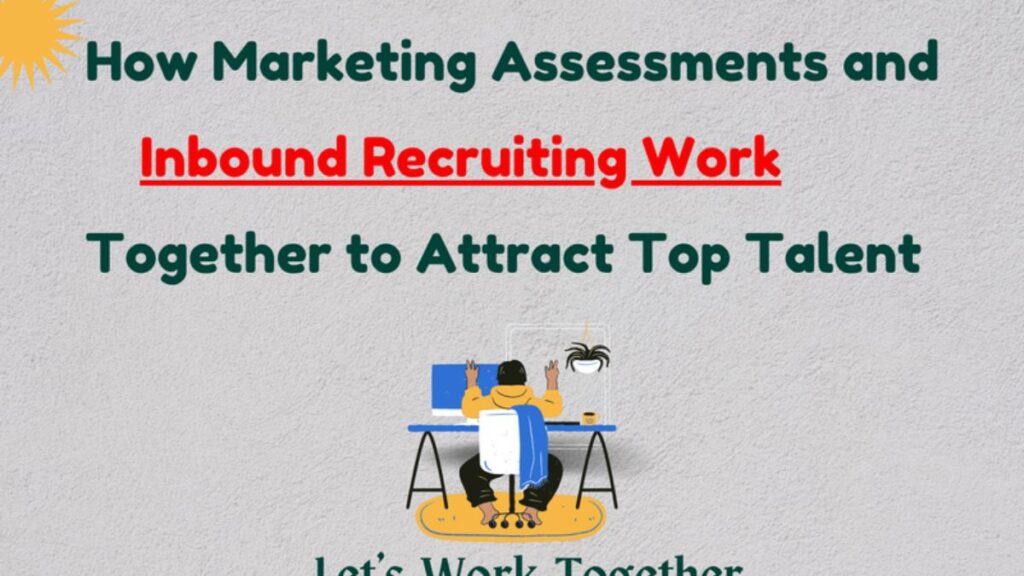In today’s highly competitive job market, attracting and retaining the best talent requires more than a well-written job description. Just as marketers have shifted towards inbound marketing strategies to engage customers organically, recruiters are increasingly adopting inbound recruiting tactics to attract top candidates. By leveraging marketing assessments and inbound recruiting, organizations can create a cohesive, compelling, and efficient approach to hiring that aligns with how top talent searches for and chooses new job opportunities.
In this blog, we’ll explore how marketing assessments can enhance inbound recruiting efforts and how the synergy between these two strategies can create a powerful hiring engine that appeals to candidates and delivers long-term recruitment success.
What is Inbound Recruiting?
Inbound recruiting is a recruitment strategy that uses the principles of inbound marketing to attract potential candidates by creating engaging, valuable content that naturally pulls candidates to an organization. The goal is to make the organization an attractive employer that candidates actively seek out, much like a consumer might seek a brand after engaging with its marketing content.
Instead of focusing solely on active job seekers, inbound recruiting aims to build relationships with both active and passive candidates over time, nurturing them with targeted, valuable information. This approach not only broadens the talent pool but also fosters a stronger connection with candidates, increasing the likelihood they’ll accept an offer when the right opportunity arises.
Key components of an inbound recruiting strategy include:
Content Marketing: Creating blogs, videos, and other resources that highlight company culture, career growth opportunities, and employee success stories.
Employer Branding: Building a strong online presence that reflects the company’s values, mission, and work environment.
Candidate Nurturing: Engaging with potential candidates over time through newsletters, updates, and personal outreach to keep the organization top-of-mind.
The Role of Marketing Assessments in Inbound Recruiting
A Marketing test is typically used to evaluate the effectiveness of a company’s marketing strategies, helping to gauge audience engagement, identify high-performing content, and refine branding messages. These assessments play a crucial role in inbound recruiting by helping organizations understand what resonates with potential candidates, allowing them to fine-tune their recruiting messages and channels.
Just as a marketer would assess customer engagement metrics to understand what content drives purchases, a recruiter can use marketing assessments to understand what content draws in the best candidates. Here’s how marketing assessments can support inbound recruiting:
Defining Candidate Personas: By analyzing engagement data, recruiters can identify the types of content and messaging that resonate with different candidate profiles. For instance, data may reveal that engineering candidates prefer technical blog posts, while candidates for customer support roles respond better to team stories and employee testimonials.
Optimizing Content: Marketing assessments can help recruiters evaluate which blogs, social media posts, or career page sections generate the most interest. This data can inform the creation of new content that speaks directly to candidate needs and career aspirations.
Enhancing Employer Branding: A company’s employer brand should be a true reflection of its culture and values. Marketing assessments can reveal whether content around company culture, mission, and values is resonating with potential candidates. For example, if “day in the life” videos featuring team members generate high engagement, recruiters might focus more on similar video content.
Improving Candidate Experience: Marketing assessments help recruiters understand the candidate journey and pinpoint areas for improvement. If data shows that potential candidates often leave the careers page after a certain point, recruiters can redesign that part of the page to better meet candidate needs, whether by adding FAQs, salary transparency, or clear next steps in the application process.
How Marketing Assessments and Inbound Recruiting Work Together
When marketing assessments and inbound recruiting work in tandem, recruiters gain insights that allow them to tailor every stage of the recruiting process. Here’s how this synergy can enhance each phase of recruiting:
1. Attracting Candidates
In inbound recruiting, attracting candidates begins long before a job opening is posted. Marketing assessments allow recruiters to determine what topics, keywords, and social media platforms draw the most attention from potential candidates. If assessments reveal that content about work-life balance performs well, recruiters can leverage this insight by producing more blog posts, videos, or social media content on that topic.
Through inbound recruiting, the organization becomes a thought leader and advocate in areas candidates care about, attracting those who align with the company’s values and culture.
2. Engaging and Nurturing Talent Pools
Marketing assessments can help determine what types of engagement drive candidate interest, whether it’s through webinars, downloadable resources, or email newsletters. By creating relevant and engaging content, recruiters can build relationships with candidates who aren’t actively seeking a job but may be open to opportunities in the future.
For instance, marketing assessments might reveal that software developers are highly engaged with technical webinars or “hackathons” hosted by the company. With this information, recruiters can focus on hosting similar events as part of their inbound recruiting strategy, keeping potential candidates engaged and fostering a sense of connection to the brand over time.
3. Converting Candidates to Applicants
Once candidates are engaged, the next step is to convert them into applicants. Marketing assessments help recruiters pinpoint which calls to action (CTAs) are most effective, such as “apply now,” “join our talent community,” or “learn more about our team.” If data shows that candidates respond well to joining a talent community, recruiters can emphasize this option more prominently, gradually leading candidates down the path to applying.
Furthermore, marketing assessments can indicate which job postings generate the most clicks and applications. This data is invaluable for crafting job descriptions that effectively capture candidate interest and encourage them to take the next step.
4. Closing and Onboarding Candidates
Closing candidates is the final step, and marketing assessments continue to provide value here. Insights from past successful hires can reveal what types of content resonated most during the recruitment journey, helping recruiters tailor closing messages to reinforce these appealing aspects. Marketing assessments can also inform onboarding materials, ensuring new hires feel connected to the organization from day one.
For example, if assessments show that candidates were particularly drawn to content about professional development, recruiters can highlight onboarding resources and growth opportunities in their closing conversations. A well-informed closing process, backed by marketing assessment data, helps reinforce why a candidate chose to join, leading to a smoother transition and stronger employee engagement.
Key Metrics to Track for Success
To maximize the impact of marketing assessments and inbound recruiting, it’s crucial to track specific metrics that reveal candidate preferences, engagement levels, and conversion rates:
Content Engagement: Track views, clicks, and shares of content geared toward potential candidates. High engagement signals that the content is relevant, while low engagement suggests areas for improvement.
Conversion Rates: Measure the percentage of candidates who progress from one stage to the next, such as from career page visitors to talent community members, or from talent community members to applicants.
Time on Site: Analyze how much time candidates spend on various pages of the career site. If they linger on culture-related content, it may indicate that candidates are drawn to the company’s values and environment.
Source of Hire: Track the origin of candidates who eventually get hired, whether it’s from social media, blogs, or direct applications. This data shows which inbound channels yield the highest-quality candidates, helping refine future efforts.
Retention and Satisfaction Rates: Post-hire assessments and surveys can provide valuable feedback on how well the recruiting content aligned with the actual employee experience. Retention and job satisfaction rates can reflect the effectiveness of the inbound recruiting and marketing assessment efforts.
Conclusion: Building a Unified Talent Attraction Strategy
By integrating marketing assessments with inbound recruiting, organizations can create a data-driven recruiting process that attracts the right talent, engages candidates meaningfully, and builds a strong employer brand. This approach not only aligns with modern candidate expectations but also sets the stage for lasting relationships with top talent.
In a competitive job market, the best talent doesn’t just want a job; they want to be part of a brand that resonates with their values and career aspirations. When marketing assessments and inbound recruiting work together, companies can build a pipeline of interested, qualified, and engaged candidates—transforming the hiring process into a seamless, effective, and people-focused journey.






